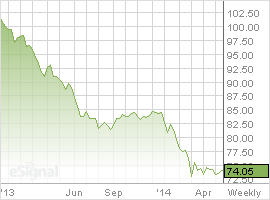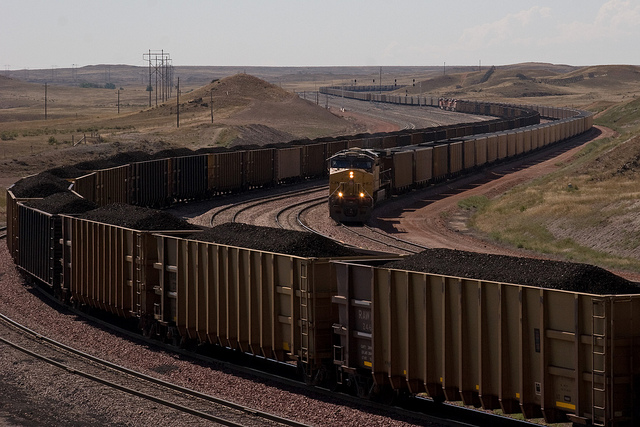Executives of Cloud Peak Energy recently admitted something that once seemed impossible: Cloud Peak has been losing money on coal exports for most of the past year. Worse, the company has locked itself into long-term export commitments—which means that Cloud Peak has essentially no choice but to continue losing money on coal exports.
Cloud Peak’s most recent financial filings, along with the associated conference call with investors, offer four key data points showing how and why the company is losing money selling coal to Asia:
1. Coal costs exceed coal revenue. Cloud Peak’s most recent 8-K filing with the SEC shows that the company’s export arm paid $59.7 million to export coal in the first quarter of 2014, but only took in $58.5 million in revenue from its customers. Based on that limited measure—one that doesn’t include various corporate, marketing, and overhead costs—Cloud Peak’s export arm saw costs exceed revenues by $1.2 million last quarter.
2. Cloud Peak’s export “earnings” came from bets that coal prices would fall. Cloud Peak’s export division overall reported a paltry $400,000 in earnings for the first quarter of 2014. But at the same time the company made $3.4 million from the coal futures markets—i.e., betting that coal prices would go down. So if you ignore what Cloud Peak made betting against coal, the company actually lost $3 million from the day-to-day operations of its coal export division. (This figure is more comprehensive than the $1.2 million in direct losses identified above…but it still doesn’t include all of the corporate expenses associated with coal exports.)
3. Cloud Peak’s CEO admitted that it can’t make money at today’s prices. In Cloud Peak’s April 29 investor conference call, the company’s CEO admitted that it needs to see much higher international coal prices before it can make a profit selling coal to Asia:
Neil Mehta – Goldman Sachs: [What] Newcastle price do you need to make it to be — PRB in the money relative to Asian coal?
Colin Marshall – President & CEO: [I]t’s between $80 and $90 I think and maybe $85 is a good a number as any.

Right now, Australian benchmark coal prices stand at about $74—which, according to Cloud Peak’s head honcho, is about $11 per ton lower than it needs to be for Cloud Peak to squeeze a profit from the export market.
4. Despite the ongoing losses, Cloud Peak has locked itself into its export strategy. In Cloud Peak’s most recent investor conference call, one financial analyst noticed what we noticed: that international coal prices are low, and that the company has been losing money on export sales and was only making money on derivatives. And he asked the obvious question: why bother exporting coal at all?
Lucas Pipes – Brean Capital: At what level would it…make more sense to sell the Spring Creek coal domestically and still take that gain on the derivatives?
The fumbling response from Cloud Peak’s CEO was telling:
Colin Marshall – President & CEO: Well that would — that would — when would that be? I don’t think that would make much sense quite frankly because we can’t actually sell, there’s a finite market for Spring Creek coal domestically. So we would not obviously be able to sell it. And there are also a take or pay commitments with the rail and the [port], so that wouldn’t actually be an option.
Spring Creek’s domestic market is small because its coal is high in sodium, which can corrode coal boilers—meaning that only a few domestic utilities can handle it. That fact alone locks Cloud Peak into Asian markets, or risk shrinking output at the Spring Creek mine.
But more importantly, the company has signed long-term “take or pay” contracts with rail and port operators—meaning that if the company stopped exporting coal, it would still have to pay stiff contractual penalties for not exporting coal. This is the exact same issue that has saddled Arch Coal, another PRB producer, with about $50 million dollars of useless costs in 2014—costs that Arch has been forced to accept, because the firm would lose even more money if it tried to sell its coal in today’s overseas market.
In short, both Cloud Peak’s financial disclosures and the statements of its top executives make it perfectly clear that the company is losing money selling coal to Asia—and that prices will have to rise substantially before the company can hope to earn a significant profit. Yet because of the way the company has locked itself into its export strategy, Cloud Peak has essentially no choice but to continue to export coal at a loss.
Who knows how long this will last. If international coal prices rise far enough, fast enough, Cloud Peak could begin to make a bit of money again on exports. But unless that happens, I think we can expect to see Cloud Peak’s export sales program continue to weigh down the company’s bottom line.

